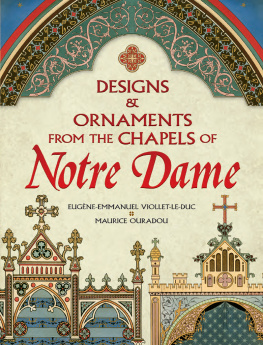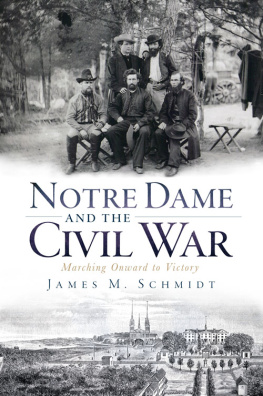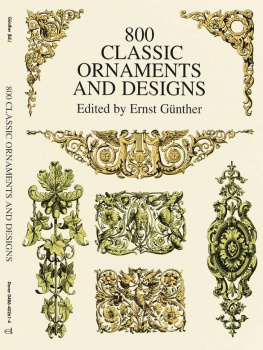Eugène-Emmanuel Viollet-le-Duc - Designs and Ornaments from the Chapels of Notre Dame
Here you can read online Eugène-Emmanuel Viollet-le-Duc - Designs and Ornaments from the Chapels of Notre Dame full text of the book (entire story) in english for free. Download pdf and epub, get meaning, cover and reviews about this ebook. year: 2019, publisher: Courier Publishing, genre: Religion. Description of the work, (preface) as well as reviews are available. Best literature library LitArk.com created for fans of good reading and offers a wide selection of genres:
Romance novel
Science fiction
Adventure
Detective
Science
History
Home and family
Prose
Art
Politics
Computer
Non-fiction
Religion
Business
Children
Humor
Choose a favorite category and find really read worthwhile books. Enjoy immersion in the world of imagination, feel the emotions of the characters or learn something new for yourself, make an fascinating discovery.
- Book:Designs and Ornaments from the Chapels of Notre Dame
- Author:
- Publisher:Courier Publishing
- Genre:
- Year:2019
- Rating:4 / 5
- Favourites:Add to favourites
- Your mark:
- 80
- 1
- 2
- 3
- 4
- 5
Designs and Ornaments from the Chapels of Notre Dame: summary, description and annotation
We offer to read an annotation, description, summary or preface (depends on what the author of the book "Designs and Ornaments from the Chapels of Notre Dame" wrote himself). If you haven't found the necessary information about the book — write in the comments, we will try to find it.
Designs and Ornaments from the Chapels of Notre Dame — read online for free the complete book (whole text) full work
Below is the text of the book, divided by pages. System saving the place of the last page read, allows you to conveniently read the book "Designs and Ornaments from the Chapels of Notre Dame" online for free, without having to search again every time where you left off. Put a bookmark, and you can go to the page where you finished reading at any time.
Font size:
Interval:
Bookmark:

 Copyright Copyright 2011 by Dover Publications, Inc. All rights reserved. Bibliographical NoteDesigns and Ornaments from the Chapels of Notre Dame, first published by Dover Publications, Inc., in 2011, is a republication of images from Peintures Murales des Chapelles de Notre-Dame de Paris, published by A. Morel, Paris, in 1870. A Publishers Note has been written specially for this edition. [Peintures murales des chapelles de Notre-Dame de Paris. [Peintures murales des chapelles de Notre-Dame de Paris.
Copyright Copyright 2011 by Dover Publications, Inc. All rights reserved. Bibliographical NoteDesigns and Ornaments from the Chapels of Notre Dame, first published by Dover Publications, Inc., in 2011, is a republication of images from Peintures Murales des Chapelles de Notre-Dame de Paris, published by A. Morel, Paris, in 1870. A Publishers Note has been written specially for this edition. [Peintures murales des chapelles de Notre-Dame de Paris. [Peintures murales des chapelles de Notre-Dame de Paris.
English] Designs and ornaments from the chapels of Notre Dame / Euge`ne-Emmanuel Viollet-le-Duc and Maurice Ouradou.
p. cm. Originally published: Peintures murales des chapelles de Notre-Dame de Paris. Paris : A. Morel, 1870. ISBN-13: 978-0-486-84050-5 ISBN-10: 0-486-84050-6 1.
Viollet-le-Duc, Euge`ne-Emmanuel, 18141879Themes, motives. 2. Notre-Dame de Paris (Cathedral) 3. Church decoration and ornamentFranceParisHistory19th century. I. II. Title. Title.
NK2192.F84V566 2011 726.50944'361dc22 2010047040 Manufactured in the United States by LSC Communications 84050601 2019 www.doverpublications.com PUBLISHERS NOTE One of the masterpieces of world architecture, the Cathedral of Notre Dame as it exists today is the culmination of countless renovations. Located on the Ile de la Citthe medieval island within Paris regarded as the citys centerNotre Dame was constructed near the site of Saint Stephens cathedral. Saint Stephens was built between the fourth and seventh centuries (excavations have failed to determine the original date), following the transition from pagan worship to the establishment of Christianity in the region. In the mid-twelfth century, with the election of Maurice de Sully as the bishop of Paris, a decision was made to build another cathedral near Saint Stephens. Paris was growing in influence, and erecting a larger, more elaborate cathedral would reflect the importance of the city. Saint Stephens would be demolished to make way for the new building.
Drawing upon the medieval gothic style, builders during the twelfth and early thirteenth centuries added to the original plan a choir with a high altar, side aisles and tribunes in the nave, towers on the faade, and side chapels in the nave; the installation of stained glass and paintings added color to the cathedral. The lack of light within the building led to the enlarging of the windowsthe darkness was thus relieved, and a more modern illumination was achieved. Although the first builder remains anonymous, later contributors to the construction include Jean de Chelles and Pierre de Montreuil. In many cases, designs begun by one architect were altered by his successor, and de Montreuil, who followed de Chelles, was more highly regarded for his contributions. Additional developments in the late thirteenth and early fourteenth centuries included the construction of the choir chapels and the placement of a stone screen around the choir. During the seventeenth and eighteenth centuries (Notre Dame was by then in need of renovation), the sanctuary and choir were refurbished, and the stained glass windows, darkened with age, were replaced.
Louis XIII, in 1638, believing his prayers to the Virgin to have been answered after his recovery from an illness, dedicated the cathedral to her. The French Revolution (late eighteenth century) brought its own changes to Notre Dame: numerous statues in the Gallery of Kings, as well as major portal statues, were destroyed, and the spire, dating from the thirteenth century, was removed. Perhaps the most significant event to impact Notre Dame thereafter was the publication of The Hunchback of Notre-Dame (1831). It was already apparent that the cathedral was in need of repairs, and the grand success of Victor Hugos novel led to a call for the restoration of the cathedral; ideally, restorations were to be made using original materials, and were to be consistent with the period. The formation of a committee in 1841 soon led to a full-blown campaign, which solicited plans from architects such as Jean-Jacques Arveuf, Jean-Baptiste Lassus, Eugne-Emmanuel Viollet-le-Duc, and Jean-Charles Danjoy. Lassus and Viollet-le-Duc were chosen by the committee, and a budget was prepared.
Work began in 1845; a new budget was required by 1850. After Lassuss death in 1857, Viollet-le-Duc took over the restoration. His contributions to the restoration of Notre Dame included the redesign of the outer chapel windows, the reconstruction of the spire above the crossing; the renovation of one of the enormous rose windows, which he designed to be exceptionally light-giving; the installation of paintings on the walls of the side chapels; anda well-known feature of the cathedralthe addition of gargoyles and other decorative sculpted figures. In 1864, after extensive work and many cost overruns, the revamped Cathedral of Notre Dame was dedicated by the archbishop of Paris. Eugne-Emmanuel Viollet-le-Duc, along with Maurice Ouradou, his son-in-law and the inspector of the renovations being carried out at Notre Dame, produced a compilation of designs and ornamental features of mural paintings in the cathedrals chapels. [The Plate numbers correspond to the Plan of Notre Dame that appears at the beginning of this book (Plate A)].
This splendid collection of images includes both abstract and representational elements, including Christian iconography. The motifs themselves range from floral patterns and charged animals to geometric designs, scrollwork, and checkerboards. Architectural details appear as well. A gargoyle can be located on , echoing Viollet-le-Ducs role in adding the famed gargoyles to Notre Dame. Rich, harmonious colors inform each plate. This masterwork of religious devotion and architectural genius stands today as a monument to the many buildersknown and unknownwho gave developing Christianity a foothold in one of the worlds great capitals.
LIST OF PLATES
| PLATE 1a Plan de Notre-Dame de Paris | Plan of Notre Dame of Paris |
| PLATE 1b Detail dune Chapelle de la Nef | Detail of a Nave Chapel |
| PLATE 1 Peinture derrire la Vierge | Painting behind the Virgin |
| PLATE 2 Peinture derrire la Vierge | Painting behind the Virgin |
| PLATE 3 Chapelle des Fonts Baptismaux | Chapel of Baptismal Fonts |
| PLATE 4 Chapelle St. Charles | Saint Charles Chapel |
| PLATE 5 Chapelle St. Charles | Saint Charles Chapel |
| PLATE 6 Chapelle de la Ste. Enfance | Chapel of the Childrens Saint |
| PLATE 7 Chapelle de la Ste. Enfance | Chapel of the Childrens Saint |
| PLATE 8 Chapelle St. Vincent de Paul | Saint Vincent de Paul Chapel |
| PLATE 9 Chapelle St. Vincent de Paul | Saint Vincent de Paul Chapel |
| PLATE 10 Chapelle St. Franois Xavier | Saint Francis Xavier Chapel |
| PLATE 11 Chapelle St. Franois Xavier | Saint Francis Xavier Chapel |
| PLATE 12 Chapelle St. Landry | Saint Landry Chapel |
| PLATE 13 Chapelle St. Landry | Saint Landry Chapel |
| PLATE 14 Chapelle Ste. Clotilde | Saint Clotilde Chapel |
| PLATE 15 Chapelle Ste. Clotilde |
Font size:
Interval:
Bookmark:
Similar books «Designs and Ornaments from the Chapels of Notre Dame»
Look at similar books to Designs and Ornaments from the Chapels of Notre Dame. We have selected literature similar in name and meaning in the hope of providing readers with more options to find new, interesting, not yet read works.
Discussion, reviews of the book Designs and Ornaments from the Chapels of Notre Dame and just readers' own opinions. Leave your comments, write what you think about the work, its meaning or the main characters. Specify what exactly you liked and what you didn't like, and why you think so.







